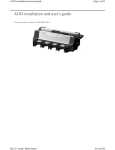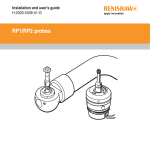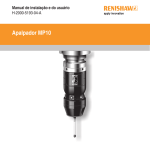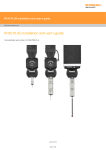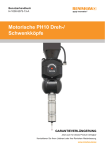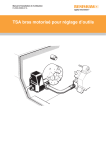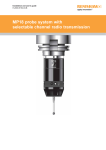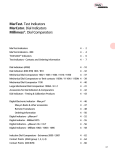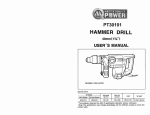Download Renishaw PH10 User`s guide
Transcript
H-1000-5070-09-A =>?@D PH10 Series User’s Guide © 2001 Renishaw. All rights reserved. Renishaw® is a registered trademark of Renishaw plc. This document may not be copied or reproduced in whole or in part, or transferred to any other media or language, by any means without the written prior permission of Renishaw. The publication of material within this document does not imply freedom from the patent rights of Renishaw plc. Disclaimer Considerable effort has been made to ensure that the contents of this document are free from inaccuracies and omissions. However, Renishaw makes no warranties with respect to the contents of this document and specifically disclaims any implied warranties. Renishaw reserves the right to make changes to this document and to the product described herein without obligation to notify any person of such changes. Care of equipment Renishaw probes and associated systems are precision tools used for obtaining precise measurements and must therefore be treated with care. Changes to equipment Renishaw reserves the right to improve, change or modify its hardware or software without incurring any obligations to make changes to Renishaw equipment previously sold. Warranty Renishaw plc warrants its equipment for a limited period (as set out in our Standard Terms and Conditions of Sale) provided that it is installed exactly as defined in associated Renishaw documentation. Prior consent must be obtained from Renishaw if non-Renishaw equipment (e.g. interfaces and/or cabling) is to be used or substituted for Renishaw equipment. Failure to comply with this will invalidate the Renishaw warranty. Claims under warranty must be made from authorised Service Centres only, which may be advised by the supplier or distributor. Patents Features of the products shown in this guide, and features of similar products, are the subjects of the following patents and patent applications. EP 0068899 EP 0142373 EP 0243766 EP 0293036 EP 0388993 EP 0501710 EP 0544854 EP 0740768 EP 0750171 EP 279828 B EP 548328 B EP 566719 B JP 1556462 JP 2,098,080 JP 2,510,804 JP 2,545,082 JP 2,647,881 JP 501,776/1994 JP 503,652/1994 JP 507,918/1997 JP 508,476/1993 US 4462162 US 4651405 US 4813151 US 4916339 US 5,323,540 US 5,327,657 US 5,339,535 US 5,345,689 US 5,404,649 US 5,505,005 US 5,755,038 TW UM-099300 Renishaw plc PH10 Motorised Probe Head Series User's Guide FCC (U.S.A.) Information to user (FCC section 15.105) This equipment has been tested and found to comply with the limits for a Class A digital device, pursuant to Part 15 of the FCC Rules. These limits are designed to provide reasonable protection against harmful interference when the equipment is operated in a commercial environment. This equipment generates, uses and can radiate radio frequency energy and, if not installed and used in accordance with the instruction manual, may cause harmful interference to radio communications. Operation of this equipment in a residential area is likely to cause harmful interference, in which case you will be required to correct the interference at your own expense. Information to user (FCC section 15.21) The user is cautioned that any changes or modifications not expressly approved by Renishaw plc or its authorised representative could void the user's authority to operate the equipment. Special accessories (FCC section 15.27) The user is also cautioned that any peripheral device installed with this equipment such as a computer, must be connected with a high-quality shielded cable to insure compliance with FCC limits. 2 PH10 Series User's Guide WARNINGS GB Pinch hazards exist between moving parts and between moving and static parts. Do not hold the probe head during movements, or during manual probe changes. Beware of unexpected movement. The user should remain outside of the full working envelope of probe head/extension/probe combinations. In all applications involving the use of machine tools or CMMs, eye protection is recommended. There are no user serviceable parts inside Renishaw mains powered units. Return defective units to an authorised Renishaw Customer Service Centre. Replace blown fuses with new components of the same type. Refer to the SAFETY section of the relevant product documentation. For instructions regarding the safe cleaning of Renishaw products, refer to the MAINTENANCE section of the relevant product documentation. Remove power before performing any maintenance operations. Refer to the machine supplier's operating instructions. It is the machine supplier's responsibility to ensure that the user is made aware of any hazards involved in operation, including those mentioned in Renishaw product documentation, and to ensure that adequate guards and safety interlocks are provided. Under certain circumstances the probe signal may falsely indicate a probe seated condition. Do not rely on probe signals to stop machine movement. The expected method of providing an emergency stop for Renishaw products is to remove power. PH10 Series User's Guide 3 AVERTISSEMENTS F L'effet de pincement dû au mouvement des pièces mobiles entre elles ou avec des pièces fixes présente des dangers. Ne pas tenir la tête du palpeur lorsqu'elle se déplace ou que le palpeur est changé à la main. Attention aux mouvements brusques. L'utilisateur doit toujours rester en dehors de la zone de sécurité des installations multiples tête de palpeur/ rallonge/palpeur. Le port de lunettes de protection est recommandé pour toute application sur machine-outil et MMC. Aucune pièce des machines Renishaw alimentées sur secteur ne peut être réparée par l'utilisateur. Renvoyer toute machine défectueuse à un Centre Après Vente Renishaw agréé. Remplacer les fusibles grillés par des composants neufs du même type. Consulter la section SAFETY (SECURITE) de votre documentation. Les conseils de nettoyage en toute sécurité des produits Renishaw figurent dans la section MAINTENANCE de votre documentation. Mettre la machine hors tension avant d'entreprendre toute opération de maintenance. Consulter le mode d’emploi du fournisseur de la machine. Il incombe au fournisseur de la machine d’assurer que l’utilisateur prenne connaissance des dangers d'exploitation, y compris ceux décrits dans la documentation du produit Renishaw, et d'assurer que des protections et verrouillages de sûreté adéquats soient prévus. Dans certains cas, il est possible que le signal du palpeur indique à tort que le palpeur est au repos. Ne pas se fier aux signaux du palpeur qui ne garantissent pas toujours l’arrêt de la machine. La procédure habituelle d’arrêt d'urgence des produits Renishaw est la mise hors tension. 4 PH10 Series User's Guide ACHTUNG D Zwischen beweglichen und zwischen beweglichen und statischen Teilen besteht eine Einklemmgefahr. Den Meßtasterkopf nicht anfassen, wenn er sich bewegt oder wenn ein manueller Meßtasterwechsel durchgeführt wird. Auf unerwartete Bewegungen achten. Der Anwender soll sich immer außerhalb des Meßtasterkopf-Arm-Meßtaster-Bereichs aufhalten. Bei der Bedienung von Werkzeugmaschinen oder Koordinatenmeßanlagen ist Augenschutz empfohlen. Die betriebenen Renishaw-Einheiten enthalten keine Teile, die vom Anwender gewartet werden können. Im Falle von Mängeln sind diese Geräte an Ihren Renishaw Kundendienst zu senden. Durchgebrannte Sicherungen müssen mit gleichwertigen ersetzt werden. Beziehen Sie sich bitte auf SAFETY (SICHERHEITSANWEISUNGEN) in der Produktdokumentation. Anleitungen über die sichere Reinigung von Renishaw-Produkten sind in Kapitel MAINTENANCE (WARTUNG) in der Produktdokumentation enthalten. Bevor Wartungsarbeiten begonnen werden, muß erst die Stromversorgung getrennt werden. Beziehen Sie sich auf die Wartungsanleitungen des Lieferanten. Es obliegt dem Maschinenlieferanten, den Anwender über alle Gefahren, die sich aus dem Betrieb der Ausrüstung, einschließlich der, die in der Renishaw Produktdokumentation erwähnt sind, zu unterrichten und zu versichern, daß ausreichende Sicherheitsvorrichtungen und Verriegelungen eingebaut sind. Unter gewissen Umständen könnte das Meßtastersignal falscherweise melden, daß der Meßtaster nicht ausgelenkt ist. Verlassen Sie sich nicht allein auf Sondensignale, um sich über Maschinenbewegungen zu informieren. Renishaw-Produkte sollen im Notfall durch Trennen der Stromversorgung gestoppt werden. PH10 Series User's Guide 5 AVVERTENZE I Tra le parti in moto o tra le parti in moto e quelle ferme esiste effettivamente il pericolo di farsi del male pizzicandorsi. Evitare di afferrare la testina della sonda quando è in moto, oppure quando si effettuano spostamenti a mano. Fare attenzione ai movimenti inaspettati. Si raccomanda all'utente di tenersi al di fuori dell’involucro operativo della testina della sonda, prolunghe e altre varianti della sonda. Si raccomanda di indossare occhiali di protezione in applicazioni che comportano macchine utensili e macchine per misurare a coordinate. All'interno degli apparecchi Renishaw ad alimentazione di rete elettrica, non vi sono componenti adatti a interventi di manutenzione da parte dell'utente. In caso di guasto, rendere l'apparecchio a uno dei Centri di Assistenza Renishaw. I fusibili bruciati dovranno essere sostituiti con quelli dello stesso tipo. Consultare la sezione SAFETY (SICUREZZA) della documentazione del prodotto. Per le istruzioni relative alla pulizia dei prodotti Renishaw, fare riferimento alla sezione MAINTENANCE (MANUTENZIONE) della documentazione del prodotto. Prima di effettuare qualsiasi intervento di manutenzione, isolare dall’alimentazione di rete. Consultare le istruzioni d’uso del fabbricante della macchina. Il fornitore della macchina ha la responsabilità di avvertire l'utente dei pericoli inerenti al funzionamento della stessa, compresi quelli riportati nelle istruzioni della Renishaw, e di mettere a disposizione i ripari di sicurezza e gli interruttori di esclusione. E' possibile, in certe situazioni, che la sonda emetta erroneamente un segnale che la sonda è in posizione. Evitare di fare affidamento sugli impulsi trasmessi dalla sonda per arrestare la macchina. Lo stop d'emergenza per i prodotti Renishaw è l'isolamento dall'alimentazione elettrica. 6 PH10 Series User's Guide ADVERTENCIAS E Existe el peligro de atraparse los dedos entre las distintas partes móviles y entre partes móviles e inmóviles. No sujetar la cabeza de la sonda mientras se mueve, ni durante los cambios manuales de la sonda. Tener cuidado con los movimientos inesperados. El usuario debe quedarse fuera del grupo operativo completo compuesto por la cabeza de sonda/extensión/sonda o cualquier combinación de las mismas. Se recomienda usar protección para los ojos en todas las aplicaciones que implican el uso de máquinas herramientas y máquinas de medición de coordenadas. Dentro de las unidades Renishaw que se enchufan a la red, no existen piezas que puedan ser mantenidas por el usuario. Las unidades defectuosas deben ser devueltas a un Centro de Servicio al Cliente Renishaw. Sustituir los fusibles fundidos con componentes nuevos del mismo tipo. Remitirse a la sección titulada SAFETY (SEGURIDAD) en la documentación sobre el producto. Para instrucciones sobre seguridad a la hora de limpiar los productos Renishaw, remitirse a la sección titulada MAINTENANCE (MANTENIMIENTO) en la documentación sobre el producto. Quitar la corriente antes de emprender cualquier operación de mantenimiento. Remitirse a las instrucciones de manejo del proveedor de la máquina. Corresponde al proveedor de la máquina asegurar que el usuario esté consciente de cualquier peligro que implica el manejo de la máquina, incluyendo los que se mencionan en la documentación sobre los productos Renishaw y le corresponde también asegurarse de proporcionar dispositivos de protección y dispositivos de bloqueo de seguridad adecuados. Bajo determinadas circunstancias la señal de la sonda puede indicar erróneamente que la sonda está asentada. No fiarse de las señales de la sonda para parar el movimiento de la máquina. El método previsto para efectuar una parada de emergencia de los productos Renishaw es el de quitar la corriente. PH10 Series User's Guide 7 AVISOS P Figo de constrição entre peças móveis e entre peças móveis e estáticas. Não segurar a cabeça da sonda durante o movimento ou durante mudanças manuais de sonda. Tomar cuidado com movimento inesperado. O utilizador deve permanecer fora do perímetro da área de trabalho das combinações cabeça da sonda/ extensão/sonda. Em todas as aplicações que envolvam a utilização de máquinas-ferramenta e CMMs, recomenda-se usar protecção para os olhos. Não há peças que possam ser consertadas pelo utilizador dentro das unidades Renishaw alimentadas pela rede. Devolver unidades avariadas a um Centro de Atendimento a Clientes Renishaw. Substituir fusíveis fundidos por novos componentes do mesmo tipo. Consultar a secção SEGURANÇA (SAFETY) da documentação do produto. Para instruções relativas à limpeza segura de produtos Renishaw, consultar a secção MAINTENANCE (MANUTENÇÃO) da documentação do produto. Desligar a alimentação antes de efectuar qualquer operação de manutenção. Consultar as instruções de funcionamento do fornecedor da máquina. É responsabilidade do fornecedor da máquina assegurar que o utilizador é consciencializado de quaisquer perigos envolvidos na operação, incluindo os mencionados na documentação do produto Renishaw e assegurar que são fornecidos resguardos e interbloqueios de segurança adequados. Em certas circunstâncias, o sinal da sonda pode indicar falsamente uma condição de sonda assentada. Não confiar em sinais da sonda para parar o movimento da máquina. O método esperado de proporcionar uma paragem de emergência para produtos Renishaw é desligar a alimentação. 8 PH10 Series User's Guide ADVARSLER DK Der er risiko for at blive klemt mellem bevægelige dele og mellem bevægelige og statiske dele. Hold ikke sondehovedet under bevægelse eller under manuelle sondeskift. Pas på uventede bevægelser. Brugeren bør holde sig uden for hele sondehovedets/forlængerens/sondens arbejdsområde. I alle tilfælde, hvor der anvendes værktøjs- og koordinatmålemaskiner, anbefales det at bære øjenbeskyttelse. Der er ingen dele inde i Renishaw-enhederne, som sluttes til lysnettet, der kan efterses eller repareres af brugeren. Send alle defekte enheder til Renishaws kundeservicecenter Udskift sikringer, der er sprunget, med nye komponenter af samme type. Se i afsnittet SAFETY (SIKKERHED) i produktdokumentatione. Se afsnittet MAINTENANCE (VEDLIGEHOLDELSE) i produktdokumentationen for at få instruktioner til sikker rengøring af Renishawprodukter. Afbryd strømforsyningen, før der foretages vedligeholdelse. Se maskinleverandørens brugervejledning. Det er maskinleverandørens ansvar at sikre, at brugeren er bekendt med eventuelle risici i forbindelse med driften, herunder de risici, som er nævnt i Renishaws produktdokumentation, og at sikre, at der er tilstrækkelig afskærmning og sikkerhedsblokeringer. Under visse omstændigheder kan sondesignalet ved en fejl angive, at sonden står stille. Stol ikke på, at sondesignaler stopper maskinens bevægelse. Den forventede metode til nødstop af Renishaw-produkter er afbrydelse strømforsyningen. PH10 Series User's Guide 9 WAARSCHUWINGEN NL Er is risico op klemmen tussen de bewegende onderdelen onderling en tussen bewegende en niet-bewegende onderdelen. De sondekop tijdens beweging of tijdens manuele sondeveranderingen niet vasthouden. Oppassen voor onverwachte beweging. De gebruiker dient buiten het werkende signaalveld van de sondekop/extensie/sonde combinaties te blijven. Het dragen van oogbescherming wordt tijdens gebruik van machinewerktuigen en CMM’s aanbevolen. De onderdelen van Renishaw units die op het net worden aangesloten kunnen niet door de gebruiker onderhouden of gerepareerd worden. U kunt defecte units naar een erkend Renishaw Klantenservice Centrum brengen of toezenden. Doorgeslagen zekeringen met nieuwe componenten van hetzelfde type vervangen. U wordt verwezen naar het hoofdstuk SAFETY (VEILIGHEID) in de produktendocumentatie. Voor het veilig reinigen van Renishaw produkten wordt verwezen naar het hoofdstuk MAINTENANCE (ONDERHOUD) in de produktendocumentatie. Voordat u enig onderhoud verricht dient u de stroom uit te schakelen. De bedieningsinstructies van de machineleverancier raadplegen. De leverancier van de machine is ervoor verantwoordelijk dat de gebruiker op de hoogte wordt gesteld van de risico’s die verbonden zijn aan bediening, waaronder de risico’s die vermeld worden in de produktendocumentatie van Renishaw. De leverancier dient er tevens voor te zorgen dat de gebruiker is voorzien van voldoende beveiligingen en veiligheidsgrendelinrichtingen. Onder bepaalde omstandigheden kan het sondesignaal een onjuiste sondetoestand aangeven. Vertrouw niet op de sondesignalen voor het stoppen van de machinebeweging. In geval van nood wordt er verwacht dat het Renishaw produkt wordt stopgezet door de stroom uit te schakelen. 10 PH10 Series User's Guide VARNING SW Risk för klämning existerar mellan rörliga delar och mellan rörliga och stillastående delar. Håll ej i sondens huvud under rörelse eller under manuella sondbyten. Se upp för plötsliga rörelser. Användaren bör befinna sig utanför arbetsområdet för sondhuvudet/förlängningen/sond-kombinationerna. Ögonskydd rekommenderas för alla tillämpningar som involverar bruket av maskinverktyg och CMM. Det finns inga delar som användaren kan utföra underhåll på inuti Renishaws nätströmsdrivna enheter. Returnera defekta delar till ett auktoriserat Renishaw kundcentra. Byt ut smälta säkringar med nya av samma typ. Se avsnittet SAFETY (SÄKERHET) i produktdokumentationen. För instruktioner angående säker rengöring av Renishaws produkter, se avsnittet MAINTENANCE (UNDERHÅLL) i produktdokumentationen. Koppla bort strömmen innan underhåll utförs. Se maskintillverkarens bruksanvisning. Maskinleverantören ansvarar för att användaren informeras om de risker som drift innebär, inklusive de som nämns i Renishaws produktdokumentation, samt att tillräckligt goda skydd och säkerhetsförreglingar tillhandahålls. Under vissa omständigheter kan sondens signal falskt ange att en sond är monterad. Lita ej på sondsignaler för att stoppa maskinens rörelse. Metoden för nödstopp för Renishaws produkter förutsätter att strömmen kopplas bort. PH10 Series User's Guide 11 VAROITUKSIA FIN Liikkuvien osien sekä liikkuvien ja staattisten osien välillä on olemassa puristusvaara. Älä pidä kiinni anturin päästä sen liikkuessa tai vaihtaessasi anturia käsin. Varo äkillistä liikettä. Käyttäjän tulee pysytellä täysin anturin pään/jatkeen/ anturin yhdistelmiä suojaavan toimivan kotelon ulkopuolella. Kaikkia työstökoneita ja koordinoituja mittauskoneita (CMM) käytettäessä suositamme silmäsuojuksia. Sähköverkkoon kytkettävät Renishaw-tuotteet eivät sisällä käyttäjän huollettavissa olevia osia. Vialliset osat tulee palauttaa valtuutetulle Renishaw-asiakaspalvelukeskukselle. Vaihda palaneiden sulakkeiden tilalle samantyyppiset uudet sulakkeet. Lue tuoteselosteen SAFETY (TURVALLISUUTTA) koskeva osa. Renishaw-tuotteiden turvalliset puhdistusohjeet löytyvät tuoteselosteen MAINTENANCE (HUOLTOA) koskevasta osasta. Kytke pois sähköverkosta ennen huoltotoimenpiteitä. Katso koneen toimittajalle tarkoitettuja käyttöhjeita. Koneen toimittaja on velvollinen selittämään käyttäjälle mahdolliset käyttöön liittyvät vaarat, mukaan lukien Renishaw’n tuoteselosteessa mainitut vaarat. Toimittajan tulee myös varmistaa, että toimitus sisältää riittävän määrän suojia ja lukkoja. Tietyissä olosuhteissa anturimerkki saattaa osoittaa virheellisesti, että kyseessä on anturiin liittyvä ongelma. Älä luota anturimerkkeihin koneen liikkeen pysäyttämiseksi. Renishaw-tuotteiden hätäpysäytys tehdään tavallisesti kytkemällä sähkö pois. 12 PH10 Series User's Guide PH10 Series User's Guide 13 SAFETY ELECTRICAL REQUIREMENTS The PHC10-2 is powered from the a.c. mains supply via an IEC 320 connector. The operating voltages of the unit are as follows: 85 - 264V ac 47 - 66Hz 30W maximum FUSE REPLACEMENT There are two 2 Amp (T) slow-blow fuses which are used for all voltages (one is a spare). Fuses are replaced as follows: 1. Disconnect the mains power. 2. Use a screwdriver to lever out the fuseholder to reveal the fuse. 3. Remove the fuse and replace it with a 2 Amp (T) HBC 20mm x 5mm fuse, rating as IEC 127. 4. Replace the fuseholder. 5. Reconnect the mains power. WARNING: Make sure that only fuses of the specified type are used for replacement. This equipment must be connected to a protective earth conductor via a three core mains (line) cable. The mains plug shall be inserted only into a socket outlet provided with a protective earth contact. The protective earth contact shall not be negated by the use of an extension cable without protective conductor. WARNING: Any interruption of the protective conductor may make the equipment dangerous. Make sure that the grounding requirements are strictly observed. ENVIRONMENTAL REQUIREMENTS The following environmental conditions comply with (or exceed) BS EN 61010-1:1993 Indoor use IP30 (no protection against water) Altitude Operating temperature PH10 PHC10-2 Storage temperature Relative humidity PH10 PHC10-2 Transient overvoltages Pollution degree Up to 2000m +10°C to 40°C 0°C to +50°C -10°C to +70°C 80% maximum for temperatures up to +31°C, linear decrease to 50% at +40°C 80% maximum for temperatures up to +31°C, linear decrease to 50% at +50°C Installation category II 2 14 PH10 Series User's Guide CONTENTS CONTENTS 1.0 2.0 Page INTRODUCTION SYSTEM DESCRIPTION 2.1 Introduction 2.2 PH10 motorised probe head range 2.3 Features 2.4 PH10T 2.5 PH10M 2.6 PH10MQ 2.7 Probe head specification 2.8 PHC10-2 probe head controller 2.9 HCU1 hand control unit 2.10 PH10 probe carrying capability 2.11 Connection of probes and extensions 2.12 Probes 2.13 Probe extension bars 2.14 Styli 3.0 ACCESSORIES 3.1 Adjustment modules 3.2 Gram gauge 3.3 Machine checking gauge 3.4 Universal datum sphere 3.5 Autochange rack 4.0 SYSTEM OPERATION 4.1 Introduction 4.2 Operating modes 4.3 Dos and Don'ts 5.0 TROUBLESHOOTING 5.1 Introduction 5.2 Poor measurement performance 5.3 No probe signal 5.4 No head movement 5.5 Datum error 5.6 Obstruct error 5.7 Overload error 6.0 MAINTENANCE 6.1 Maintenance 6.2 Cleaning USER REGISTRATION 16 17 17 18 18 19 20 21 22 23 27 28 30 32 34 38 39 39 42 43 44 45 46 46 47 48 49 49 51 51 52 53 54 55 56 56 56 57 PH10 Series User's Guide 15 INTRODUCTION 1.0 INTRODUCTION This User's Guide will enable you to maximise the performance of your PH10 system and ensure, safe reliable operation. Please fill in the user registration form at the end of this guide and return it to Renishaw plc to obtain further information on the PH10 system and accessories. This will enable Renishaw to keep you informed of the latest product information, special offers, upgrade news and new product developments. You may find it useful to note below information about your system. CMM make CMM model Head serial number PHC10-2 serial number PHC10-2 version number NOTE There may be variations in the installation and use of the PH10 range of motorised probe heads on different CMMs This User's Guide must be read in conjunction with the documentation provided by your CMM supplier 16 PH10 Series User's Guide SYSTEM DESCRIPTION 2.0 SYSTEM DESCRIPTION 2.1 Introduction This User's Guide describes an automated inspection system using the Renishaw PH10 series of motorised probe heads; the PH10T, PH10M and PH10MQ. Information is given on the elements of the system and accessories. A typical installation is shown, followed by a description of manual mode and automatic mode operation. A list of possible operating errors is also given together with maintenance information. The installation of the PH10 system is described in the PH10 Series Installation Guide (Renishaw Part Number H-1000-5071) which is intended primarily for use by the OEM (or supplier of the CMM) for installation and commissioning purposes. WARNING The components of the PH10 system are not compatible with PH9 system components. No attempt should be made to connect PH10 system components to a PH9 system, as this will result in damage to the product. PH10 Series User's Guide 17 SYSTEM DESCRIPTION 2.2 PH10 motorised probe head range Each of the heads in the PH10 range is a general-purpose, versatile unit designed specifically for use on Direct Computer Controlled (DCC) Coordinate Measuring Machines (CMMs). The range consists of three heads: • PH10T a shank-mounted head with two-wired probe capability and an M8 thread • PH10M a shank-mounted head with multiwired probe capability and a Renishaw Autojoint • PH10MQ a quill-mounted head with multiwired probe capability and a Renishaw Autojoint 2.3 Features All the heads in the range incorporate the following features: • • • • 720 indexing positions 0.5µm indexing repeatability* 7.5° indexing steps in both axes 300mm (maximum) extension bar capability* * See Section 2.7 for specifications and test conditions. 18 PH10 Series User's Guide SYSTEM DESCRIPTION 2.4 PH10T Figure 1 shows the PH10T motorised probe head fitted with a TP200 probe. Figure 1 - PH10T B axis A axis PH10 Series User's Guide 19 SYSTEM DESCRIPTION 2.5 PH10M Figure 2 shows the PH10M motorised probe head fitted with an AM1 adjustment module and a TP7M probe. Figure 2 - PH10M B axis A axis 20 PH10 Series User's Guide SYSTEM DESCRIPTION 2.6 PH10MQ Figure 3 shows the PH10MQ motorised probe head fitted with an AM2 adjustment module and TP7M probe. Figure 3 - PH10MQ B axis A axis PH10 Series User's Guide 21 SYSTEM DESCRIPTION 2.7 Probe head specification Table 1 - Probe head specification Repeatability of position (2F) 0.5µm (0.00002in) Step 7.5° A axis 0° to 105° 15 positions B axis -180° to +180° 48 positions Positioning Probe mounting Total 720 positions PH10T M8 thread, 18mm (0.709in) diameter bush face PH10M PH10MQ Multiwired Autojoint XY Z Dimensions from quill face Weight 62mm (2.44in) square PH10T 102mm (4.09in) PH10M 117mm (4.6in) PH10MQ 73mm (2.87in) PH10T 595g (20.9oz) PH10M 620g (21.8oz) PH10MQ 730g (25.7oz) System operating temperature 10°C to 40°C (50°F to 104°F) System storage temperature -10°C to 70°C (14°F to 158°F) 22 PH10 Series User's Guide SYSTEM DESCRIPTION 2.8 PHC10-2 probe head controller The PH10 series of motorised probe heads can only be used in conjunction with the PHC10-2 controller. The PHC10-2 incorporates an integral power supply for the head, manages all head and probe functions and communicates via a suitable interface with the CMM computer. It is available in two versions: • • PHC10-2 RS232 PHC10-2 IEEE Figure 4 shows the front panel. Figure 4 - PHC10-2 front panel PH10 Series User's Guide 23 SYSTEM DESCRIPTION 2.8 PHC10-2 probe head controller continued 2.8.1 PHC10-2 specification Table 2 - PHC10-2 probe head controller specification Data transmission RS232 serial or IEEE488 parallel Power supply Universal, autoselecting Voltage range 85-264V, 47-66Hz Power connector IEC320 Fuse 2A(T) HBC 20mm x 5mm Dimensions 2/3 19in rack wide, 2U high 290mm x 88mm x 220mm (11.42in x 3.46in x 2.66in) Mounting 19in rack mounting or stand-alone 24 PH10 Series User's Guide SYSTEM DESCRIPTION 2.8 PHC10-2 probe head controller continued 2.8.2 PHC10-2 front panel Figure 5 shows the LEDs on the front panel of the PHC10-2. The names, colours and functions of the LEDs are given in Table 3. Figure 5 - LEDs Table 3 - LEDs LED NAME COLOUR DESCRIPTION POWER ON Green Power on when lit HEAD READY Green Head correctly locked up and waiting for a command HEAD ACTIVE Yellow Head moving DATUM ERROR Red Head not locked OBSTRUCT ERROR Red Head obstructed OVERLOAD ERROR Red Head overloaded STOP Red PHC10-2 signal to CMM computer PH10 Series User's Guide 25 SYSTEM DESCRIPTION 2.8 PHC10-2 probe head controller continued 2.8.3 PHC10-2 rear panel Figure 6 shows the rear panel of the PHC10-2. Figure 6 - rear panel 1 2 9 10 3 11 4 5 6 7 8 12 Key 1 2 3 Switches 1-10, communications protocol selection HCU1 connector Either RS232 communications connector or IEEE488 communications connector 4 Version number 5 Serial number 6 Main power ON/OFF switch 7 Fuse holder 8 Mains power input 9 PICS output connector 10 Switches 11-14 and 15-18, probing system format selection 11 Probe head connector 12 Probe output connector 26 PH10 Series User's Guide SYSTEM DESCRIPTION 2.9 HCU1 hand control unit The HCU1 hand control unit shown in Figure 7 is an optional control which enables the system to be used in manual mode or in a teach cycle. An LCD dot matrix display provides information on system status. Figure 7 - HCU1 For further information on features and operation, see the HCU1 User's Guide (Renishaw Part Number H-1000-5016) or contact your Renishaw supplier. PH10 Series User's Guide 27 SYSTEM DESCRIPTION 2.10 PH10 probe carrying capability Figure 8 shows the range of extensions, probes and styli which can be used in conjunction with the PH10T head. Figure 8 - Extensions, probes and styli PEL4 PEL3 PEL2 PEL1 PH10T M3 thread styli 28 PH10 Series User's Guide TP200 TP2-5w TP20 TP6 M2 thread styli SYSTEM DESCRIPTION PH10 probe carrying capability continued 2.10 Figure 9 shows the range of extensions, probes and styli which can be used in conjunction with the PH10M and PH10MQ heads. Figure 9 - Extensions, probes and styli Shank Quill AM1 AM2 PH10M PH10MQ PAA3 PEL3 PEM3 PEL2 PAA2 PEL1 PEM2 PEM1 PEM25 PAA1 M2 thread styli H TP6A TP7M TP200 TP2-5 w TP20 TP6 OTP6M M3 thread styli SP600MH M4 thread styli When using a PH10MQ with SP600M a PEM25 extension bar is required to achieve A = 97.5° or A = 105° in all B-axis positions PH10 Series User's Guide 29 SYSTEM DESCRIPTION 2.11 Connection of probes and extensions 2.11.1 M8 connection The PH10T is designed to carry Renishaw probes and extensions with an M8 screw thread (see Figure 10). Probes and extensions are screwed into the probe head bush and tightened with the appropriate spnner. CAUTION ! Never use anything other than the Renishaw spanner provided and do not apply excessive force. Figure 10 - M8 connection PEL1 extension PEL2, PEL3 or PEL 4 extension 30 PH10 Series User's Guide SYSTEM DESCRIPTION 2.11.2 Autojoint connection The PH10M and PH10MQ heads all use a Renishaw Autojoint (Figure 11) which is a highly repeatable kinematic joint, one half of which forms part of the head. The other half forms part of the adaptor, extension bar or probe. Locking and unlocking the Autojoint is carried out either manually, using the Autojoint key, or automatically using the Renishaw Autochange rack system. In both cases, the connection repeatability eliminates the need for probe requalification after exchange. Figure 11 - Autojoint connection Head Clamping mechanism Kinematic location Lock/unlock screw Electrical contacts PAA1 Adaptor PH10 Series User's Guide 31 SYSTEM DESCRIPTION 2.12 Probes 2.12.1 M8 touch-trigger probes This range of probes (see Table 4) utilises the M8 bush as a mounting to the head. These can be fitted directly onto the PH10T head, but when used with the PH10M or PH10MQ heads, one of the Autojoint to M8 bush extension bars or the PAA1 adaptor must be used (see Figure 8). Table 4 - M8 touch-trigger probes Probe Diameter Application User's Guide TP2-5W 13mm Universal probe for DCCC and manual CMMs H-1000-5021 TP6* 25mm Universal probe for DCCC and manual CMMs H-1000-5021 TP20 13mm Universal probe for DCCC and manual CMMs with module changing H-1000-5008 13mm Universal probe with strain gauges for DCC CMMs. Upto 100mm stylus carrying ability H-1000-5150 TP200 * An Autojoint version (TP6A) is also available. 32 PH10 Series User's Guide SYSTEM DESCRIPTION 2.12 Probes continued 2.12.2 Multiwired probes This range of probes (see Table 5) are compatible with the PH10M and PH10MQ heads only and utilise the Renishaw multiwired Autojoint connection to the head. Table 5 - Multiwire probe Probe Application Diameter Weight User's Guide TP7M Universal probe with strain gauges for DCC CMMs 25mm 85g (without stylus) H-1000-5010 SP600M H Analogue contact scanning probe 50mm 216g (without stylus) H-1000-5175 OTP6M Laser noncontact optical trigger probe 49mm 253g max (fitted with PEM1) H-1000-5007 Probes in this range require comprehensive integration to your CMM. H When using a PH10MQ with SP600M a PEM25 extension bar is required to achieve A = 97.5° or A = 105° in all B-axis positions PH10 Series User's Guide 33 SYSTEM DESCRIPTION 2.13 Probe extension bars Renishaw manufacture a comprehensive range of extension bars and adaptors to allow increased component penetration (see Figures 8 and 9 for allowable combinations). There are three types in the range: • • • Autojoint to M8 bush (PAA series) Autojoint to Autojoint (PEM series) M8 thread to M8 bush (PEL series) 2.13.1 Autojoint to M8 bush These extension bars connect directly to Autojoint of the PH10M or PH10MQ head and terminate in an M8 bush (see Table 6). This permits use of two-wire touch trigger probes. Table 6 - Autojoint to M8 bush extensions Extension Length Material Weight PAA1 30mm (1.18in) Steel 57g PAA2 140mm (5.51in) Aluminium 85g PAA3 300mm (11.81in) Aluminium 144g 34 PH10 Series User's Guide SYSTEM DESCRIPTION 2.13.1 Autojoint to M8 bush continued The probe is fitted to the extension by hand and tightened by use of the S1 spanner as shown in Figure 12. Figure 12 - Fitting the PAA1 extension The S1 spanner is designed to fail before damage can occur to the mechanical joint between the two parts. PH10 Series User's Guide 35 SYSTEM DESCRIPTION 2.13 Probe extension bars continued 2.13.2 Autojoint to Autojoint These extension bars are compatible with the PH10M and PH10MQ heads. They allow direct connection to the head via the Autojoint and terminate in an Autojoint (see Table 7). This permits use of a multiwired probe. Table 7 - Autojoint to Autojoint extensions Extension Length Material Weight PEM25 25mm (0.98in) Aluminium 53g PEM1 50mm (1.97in) Aluminium 64g PEM2 100mm (3.94in) Aluminium 93g PEM3 200mm (7.87) Aluminium 145g 36 PH10 Series User's Guide SYSTEM DESCRIPTION 2.13 Probe extension bars continued 2.13.3 M8 thread to M8 bush These extension bars can be used directly with the PH10T head, and also with the PH10M and PH10MQ heads using the PAA1 adaptor. Table 8 - M8 thread to M8 bush extension bars Extension Length Material Weight P E L1 50mm (1.97in) Aluminium 24g P E L2 100mm (3.94in) Aluminium 57g P E L3 200mm (7.87in) Aluminium 86g P E L4 300mm (11.81in) Aluminium 135g PH10 Series User's Guide 37 SYSTEM DESCRIPTION 2.14 Styli Renishaw manufactures an extensive range of precision styli and stylus accessories. They are available in M2, M3, M4 and M5 thread sizes with steel, tungsten carbide, graphite fibre and ceramic stems. Each is fitted with a precision industrial synthetic ruby ball available in diameters from 0.3mm (0.012in) to 8.0mm (0.31in). Special application styli including discs, cylinders, pointers, stars and large ceramic balls up to 30mm (1.18in) are available in M2 and M3 thread sizes. For further information on the Renishaw stylus range, please refer to the Styli and Accessories Technical Specifications (Renishaw Part No H-1000-3200). Renishaw also offers a custom design service if your requirements are not met by the standard range. Please contact your Renishaw supplier for details. 38 PH10 Series User's Guide ACCESSORIES 3.0 ACCESSORIES 3.1 Adjustment modules The AM1 adjustment module shown in Figure 13 is designed for use on the PH10T and PH10M. Figure 13 - AM1 adjustment module Lock/unlock screw AM1 Roll Pitch Overtravel Yaw PH10 Series User's Guide 39 ACCESSORIES 3.1 Adjustment modules continued The AM2 adjustment module shown in Figure 14 is designed for use with the PH10MQ. Figure 14 - AM2 adjustment module Roll Pitch Yaw 40 PH10 Series User's Guide ACCESSORIES 3.1 Adjustment modules continued Both modules enable adjustment in pitch, roll and yaw and allow accurate alignment with machine quill or workpiece. The AM1 offers a quick release mechanism for rapid head exchange, and features inbuilt overtravel protection. For further information on the AM1, please refer to the AM1 User's Guide (Renishaw Part Number H-1000-4010). For further information on the AM2, please refer to the AM2 New Product Information sheet (Renishaw Part Number H-1000-2051). If your CMM has been fitted with either of the modules, the relevant documentation should have been included. If not present, please contact your Renishaw supplier who will arrange for a free copy to be sent. PH10 Series User's Guide 41 ACCESSORIES 3.2 Gram gauge Probe trigger force is critical to ensure accuracy and reliable operation, and can be easily measured and set using the gram gauge as shown in Figure 15. Figure 15 - Gram gauge It is strongly recommended that the gram gauge is used when adjustments are to be made to probe trigger force. For further information on the gram gauge, please refer to the Gram Gauge Product Information sheet (Renishaw Part Number H-1000-2033). Note: To convert probe trigger force in grams to Newtons the following equation is to be used. Trigger force in grams = Trigger force in Newtons 100 42 PH10 Series User's Guide ACCESSORIES 3.3 Machine checking gauge The Renishaw machine checking gauge shown in Figure 16 enables rapid and effective interim checking of CMM performance as recommended by many standards for CMM volumetric performance assessment. Figure 16 - Machine checking gauge +45° 0° -45° Please contact your Renishaw representative to arrange a demonstration, or refer to the Machine Checking Gauge User's Guide (Renishaw Part Number H-1000-5080). PH10 Series User's Guide 43 ACCESSORIES 3.4 Universal datum sphere The Renishaw universal datum sphere shown in Figure 17 features quick and easy alignment of its ball stem over a wide range of angles, allowing clearance for probe qualification above, centrally and below the ball. Figure 17 - Universal datum sphere Each hard-wearing tungsten carbide sphere is supplied with a test certificate traceable to UK (National Physical Laboratory) standards. For further information on the sphere please refer to the Universal Datum Sphere Data Sheet (Renishaw Part Number H-1000-2055). 44 PH10 Series User's Guide ACCESSORIES 3.5 Autochange rack Renishaw's Autochange rack shown in Figure 18 is a fullyintegrable probe exchange system available for use with the PH10M and PH10MQ probe heads. Mounted within the CMM working envelope, the Autochange system facilitates fast, automatic probe exchange without the need for requalification. Figure 18 - Autochange rack Fast 'probing to probing' cycles are achieved by the head docking one probe and selecting another. The highly repeatable Autojoint removes the need to requalify after each exchange. PH10 Series User's Guide 45 SYSTEM OPERATION 4.0 SYSTEM OPERATION 4.1 Introduction Figure 19 shows the basic installation configuration for the PH10 system. Figure 19 - System configuration Machine cable PHC10-2 head controller Head cable connects head to machine cable Communications connection to CMM computer PICS Product Interconnection cable Probe interface (PI200) Trigger output to CMM 46 PH10 Series User's Guide HCU1 hand control unit (optional) SYSTEM OPERATION 4.2 Operating modes The PH10 system can operate in one of two modes: • • Manual mode Automatic mode 4.2.1 Manual mode In manual mode the optional HCU1 hand control unit is used to control head and probe functions. If the HCU1 is connected to the PHC10-2 controller when power is applied to the system, the system will enter manual mode. For further information refer to the HCU1 User's Guide (Renishaw Part Number H-1000-5016). 4.2.2 Automatic mode In automatic mode the system is under the control of the CMM computer. The HCU1 cannot be used to control head or probe functions in automatic mode. With no HCU1 fitted when power is applied to the system, the system will enter automatic mode. The system must be switched to manual mode under CMM control (and an HCU1 connected) for operation under manual mode. Please refer to the documentation provided by your CMM supplier for further details on controlling the PH10 series of heads using the CMM computer. PH10 Series User's Guide 47 SYSTEM OPERATION 4.3 Dos and don'ts DO ensure that the head is mounted as rigidly as possible in the CMM quill. DO take care to avoid collisions between the head and workpiece or CMM bed. DO ensure that the head is moved clear of any obstruction before requesting a position change. DO NOT apply force to any moving parts of the head. DO NOT move the head axes by hand when locked or unlocked. 48 PH10 Series User's Guide TROUBLESHOOTING 5.0 TROUBLESHOOTING 5.1 Introduction Table 9 will help you to identify problems you may be experiencing with your system. Table 9 - Troubleshooting Observation Section Poor measurement performance 5.2 No probe signal 5.3 No head movement 5.4 Datum error 5.5 Obstruct error 5.6 Overload error 5.7 If you experience problems which you are not able to identify or solve satisfactorily, please contact your Renishaw representative for further advice. The optional HCU1 is also able to diagnose certain error conditions. Please refer to the HCU1 User's Guide (Renishaw Part Number H-1000-5016) for further information. PH10 Series User's Guide 49 TROUBLESHOOTING 5.1 Introduction continued NOTE Before seeking technical assistance please make a note of the following information: • • • • • • • Your CMM make and model The probe head model number The probe head serial number The PHC10-2 serial number The PHC10-2 version number The LED sequence on the PHC10-2 The stylus configuration fitted You may already have recorded some of this information in Section 1.0 50 PH10 Series User's Guide TROUBLESHOOTING 5.2 Poor measurement performance Table 10 - Poor measurement performance Possible cause Checks/remedies Loose head mounting Ensure all mounting screws are tight and mounting to the CMM is secure Probe incorrectly installed Remove probe and refit Force applied to head during lock up Unlock and relock Incorrect lock up position or position not qualified Reposition head correctly. Check qualification information. 5.3 No probe signal Table 11 - No probe signal Possible cause Checks/remedies Probe incorrectly installed Remove probe and refit Cable/connection fault Check connections and integrity of cabling from head to controller Probe failure Contact your CMM supplier or Renishaw representative for fur ther assistance Probe output disabled by CMM Check probe output PH10 Series User's Guide 51 TROUBLESHOOTING 5.4 No head movement Table 12 - No head movement Possible cause Checks/remedies Power loss Check controller POWER ON LED is lit. Check mains cable connections and integrity, observing electrical safety precautions. Check controller fuse, observing electrical safety precautions (see page 14). Check CMM emergency stop condition power may have been removed from the system by the CMM. Cable/connection fault Check connections and integrity of cabling from head to controller. 52 PH10 Series User's Guide TROUBLESHOOTING 5.5 Datum error The DATUM ERROR LED is lit on the controller. The head has rotated to the required position but locked in a non-repeatable condition (a maximum of four attempts to lock will be made before the error is reported). Table 13 - Datum error Possible cause Checks/remedies Cable/connection fault Check connections and integrity of cabling from head to controller Head/stylus configuration obstructed Remove obstruction and update head using the HCU1 or under CMM control Extension bar too long Use shor ter bar Internal head fault Contact your Renishaw representative, CMM manufacturer or distributor PH10 Series User's Guide 53 TROUBLESHOOTING 5.6 Obstruct error The OBSTRUCT ERROR and STOP LEDs are lit on the controller. The head has been obstructed while moving but is unable to reach the requested position or to lock into it. Table 14 - Obstruct error Possible cause Checks/remedies Head/stylus configuration obstructed Check head for damage. Remove obstruction and repeat head move Probe/extension combination too long Use shor ter/lighter combination Internal head fault Contact your Renishaw representative, CMM manufacturer or distributor 54 PH10 Series User's Guide TROUBLESHOOTING 5.7 Overload error The OVERLOAD ERROR and STOP LEDs are lit on the controller. The head has been overloaded while locked. Table 15 - Overload error Possible cause Checks/remedies Head lock up holding force exceeded during CMM acceleration Reduce mass of probe/extension combination. Reduce acceleration Collision with workpiece or CMM Check head for damage. Remove obstruction and repeat move PH10 Series User's Guide 55 MAINTENANCE 6.0 MAINTENANCE 6.1 Maintenance There are no user serviceable parts inside any of the PH10 system units. The only maintenance required is fuse replacement. See page 14 for instructions on fuse replacement. Units requiring attention must be returned to an authorised Renishaw Customer Service Centre. 6.2 Cleaning The probe head, controller and hand control unit may all be wiped using a soft cloth. 56 PH10 Series User's Guide USER REGISTRATION To obtain further information on your PH10 system, and to enable Renishaw to keep you informed with the latest product news, please complete the user registration form overleaf and send it to: Customer Support Department Renishaw plc Wotton-under-Edge Gloucestershire GL12 8JR United Kingdom NOTE This information will be treated as strictly confidential and will be used by Renishaw for internal purposes only as described above PH10 Series User's Guide 57 This page intentionally left blank 58 PH10 Series User's Guide Please register me as a PH10 system user Name Position Company name Address Telephone/fax e-mail CMM make and model Please send me: o o o o o o PH10 Series Installation Guide Basic Command Set for Indexing Heads Programmer's Guide HCU1 User's Guide Styli and Accessories Technical Specifications Probing Systems for CMMs, Technical Specifications Please arrange for my nearest Renishaw representative to contact me PH10 Series User's Guide 59 Australia – Renishaw Oceania Pty Ltd Tel +61 3 9553 8267 Fax +61 3 9592 6738 email [email protected] Japan – Renishaw K.K. Tel +81 3 5332 6021 Fax +81 3 5332 6025 email [email protected] Brazil – Renishaw Latino Americana Ltda Tel +55 11 4195 2866 Fax +55 11 4195 1641 email [email protected] The Netherlands – Renishaw International BV Tel +31 76 543 11 00 Fax +31 76 543 11 09 email [email protected] The People’s Republic of China – Renishaw Representative Office Tel +86 10 6410 7993 Fax +86 10 6410 7992 email [email protected] Singapore – Renishaw Representative Office Tel +65 897 5466 Fax +65 897 5467 email [email protected] France – Renishaw S.A. Tel +33 1 64 61 84 84 Fax +33 1 64 61 65 26 email [email protected] Germany – Renishaw GmbH Tel +49 7127 9810 Fax +49 7127 88237 email [email protected] Hong Kong – Renishaw (Hong Kong) Ltd. Tel +852 2753 0638 Fax +852 2756 8786 email [email protected] India – Renishaw Metrology Systems Private Ltd Tel +91 80 5320 144 Fax +91 80 5320 140 email [email protected] Indonesia – Renishaw Representative Office Tel +62 21 428 70153 Fax +62 21 424 3934 email [email protected] Italy – Renishaw S.p.A. Tel +39 011 966 10 52 Fax +39 011 966 40 83 email [email protected] South Korea – Renishaw Liaison Office Tel +82 2 565 6878 Fax +82 2 565 6879 email [email protected] Spain – Renishaw Iberica S.A. Tel +34 93 478 21 31 Fax +34 93 478 16 08 email [email protected] Switzerland – Renishaw A.G. Tel +41 55 415 50 60 Fax +41 55 415 50 69 email [email protected] Taiwan – Renishaw Representative Office Tel +886 4 251 3665 Fax +886 4 251 3621 email [email protected] UK (Head Office) – Renishaw plc Tel +44 1453 524524 Fax +44 1453 524901 email [email protected] USA – Renishaw Inc Tel +1 847 286 9953 Fax +1 847 286 9974 email [email protected] For all Tel Fax email other countries +44 1453 524524 +44 1453 524901 [email protected] =>?@D www.renishaw.com © 2000 Renishaw Issued 0701 Part no. H-1000-5070-09-A






























































